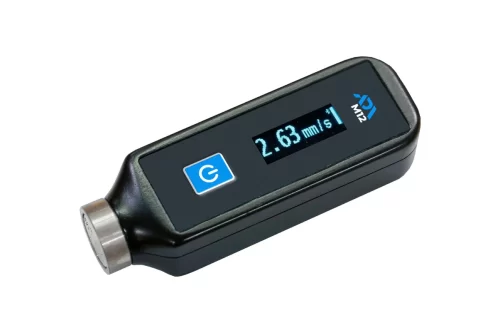Description
ADL M15 in Uzbekistan, Tashkent
This device is a unique diagnostic tool for vibration monitoring. An easy-to-use, portable Bluetooth sensor that connects to apps on tablets and smartphones. Data can be viewed in real time.
A distinctive feature and uniqueness of the ADL M15 vibrometer is that it can operate in 5 different modes:
Classic vibration meter
Classic vibration meter – this mode refers to the classic use of the device as an indicator of the overall level of vibration of the device, measuring peak values, displacement or diagnosing bearings by peak factor.
Vibration analyzer mode
Vibration analyzer mode – allows you to perform all functions as in the “classic vibration meter” mode with the ability to present the vibration spectrum and save data in professional software.
Acceleration-stabilization mode
The “acceleration-stabilization” mode applies to the initial diagnostics of equipment after repair, when switching to backup units, including pumps and electric drives, blowers, turbines, compressors, mills, gearboxes and other equipment that is subject to frequent starts and stops.
This mode allows you to record data from the moment the speed is adjusted to the operating speed, as well as from the moment the speed drops until the equipment stops completely. This then makes it possible to create a trend regarding the time dependence of the vibration amplitude. The main goal of this diagnostic is to prevent damage to equipment when the rotation speed changes and the shaft passes critical frequencies.
Tracking
Monitoring – allows you to set up a vibration meter to measure vibration after a certain period of time, such as an hour, a day or a week, and record the vibration parameters.
This mode allows complete vibration control and monitoring of any industrial equipment such as gearboxes, pumps, gas blowers, turbines, blowers, conveyors, etc.
Crawler
Crawler movement – work of maintenance personnel along a specific route with a large number of objects and control points with the possibility of using both NFC tags and sequential standard recording of vibration data.
This mode will greatly facilitate the monitoring of all equipment at the enterprise, will allow you to create an effective and convenient route for a planned walk-through and attract not only qualified specialists, but also line personnel, as well as eliminate confusion and errors in measurements.
The main advantages of the ADL M15 portable vibration meter:
- miniature design with magnetic mount and the ability to attach to an M5 rack, which completely eliminates the influence of the human factor during the measurement process;
- the ability to set parameters: time, frequency and frequency of polling;
- high degree of protection against shocks and falls;
- built-in battery;
- Fast data transfer via USB or Bluetooth;
- event recorder regardless of connection to external devices (real time clock, NFC module);
- internal flash memory for storing large amounts of data;
- built-in display with the ability to display color if the specified vibration parameters are exceeded;
- the ability to transfer data to the global system;
- preservation of emergency valuables;
- Measurement difference up to 0.01;
- bright OLED display;
- Easy to use.
As of my last update, there’s no specific information available about the “ADL M15” portable vibration meter. However, I can provide you with a general overview of what features and functionalities you might expect from a portable vibration meter:
- Vibration Measurement: A portable vibration meter like the ADL M15 would be designed to measure vibrations in machinery, structures, and components. It can detect vibrations in terms of frequency, amplitude, and other parameters to assess equipment condition and health.
- Compact and Lightweight Design: Being portable, the ADL M15 would likely have a compact and lightweight design, making it easy to carry around for on-site measurements and field applications.
- Measurement Methods: The vibration meter would use various measurement techniques such as FFT (Fast Fourier Transform) analysis, time-domain analysis, and frequency-domain analysis to capture and analyze vibrations. These methods enable the identification of vibration sources, frequencies, and patterns.
- Measurement Range: The portable vibration meter would come with a specified measurement range, indicating the frequencies and amplitudes it can accurately measure.
- Display and Controls: It would feature a display screen and user-friendly controls for intuitive operation and easy access to measurement readings, spectra, and settings.
- Battery Power: The ADL M15 would likely operate on battery power, providing flexibility for usage in various locations without the need for a power outlet.
- Applications: Portable vibration meters are used in various industries such as manufacturing, aerospace, automotive, energy, and transportation. They are used to monitor machinery health, detect faults, and prevent unexpected failures, thus playing a crucial role in predictive maintenance programs.
- Data Logging and Reporting: The vibration meter may have built-in memory for storing measurement data, facilitating later analysis and report generation. It might also be compatible with software for more in-depth data analysis and reporting.
- Calibration and Maintenance: Regular calibration and maintenance are necessary to ensure optimal performance and accuracy. The manufacturer might provide calibration instructions and support services for maintenance and technical assistance.
- Accessories and Support: The portable vibration meter might come with accessories such as accelerometers, mounting fixtures, cables, and software. Additionally, the manufacturer might offer training and technical support services to assist users in maximizing the capabilities of the device.
If the ADL M15 is a specific model, you may want to consult the manufacturer’s documentation or contact the manufacturer directly for detailed specifications and information tailored to this portable vibration meter.
Other products in category Vibration Diagnostics






